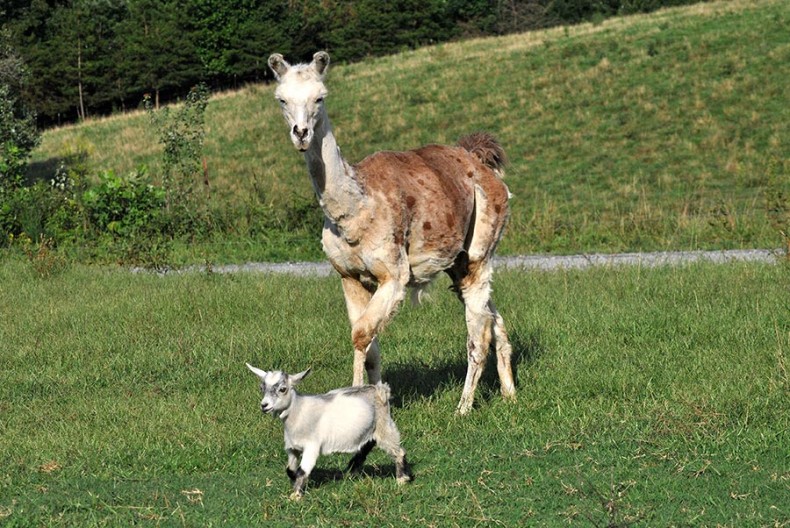On Guard
Guard animals on assignment to protect herds from coyotes
By Hannah Miller
Not even her 200-pound protector, Osama bin Llama, could save three-months-old pygmy goat Mattie here in Alexander County.
An enraged mama cow may be the first line of defense for a calf threatened by coyotes, but on Ronald and Rose Millsaps’ farm in Iredell County, the second line is a gentle-eyed, 11-year-old white donkey named Sarah.
At NC State University’s research farm near Raleigh, the sheep and goats look to two Great Pyrenees dogs, Thor and Gunner, for protection.
And at Richie and Teresa Herman’s farm in Alexander County, it’s a fuzzy, leggy 200-pound llama who stands between young lambs and potential disaster. Old, at about 10 years, and toothless, Osama bin Llama is nevertheless “a terrorist to coyotes,” says Teresa Herman, an EnergyUnited member and Iredell County agriculture Extension agent.
“If strange dogs come in, he’ll run like he’s vicious,” she says. “The neighbors have actually seen him run coyotes off.”
Click on the photo to view slideshow.
Coyotes, once unknown in North Carolina, have become such a threat to livestock, especially young livestock, that many farmers have resorted to four-footed help. “Everybody that has a sheep farm has a guard animal,” says Micah Orfield, a member of Blue Ridge Electric and an Ashe County agriculture Extension agent. Not only are coyotes more numerous now, “they’re not as scared as they once were,” she says.
Ancient shepherds
In ancient times, breeds of dogs, including the Great Pyrenees, were developed in Europe and Asia to protect unattended flocks from wolves, bears and great cats, says William B. Knox, operations manager at NCSU’s Small Ruminant Education Unit. Now, in North Carolina, not just dogs but donkeys and llamas give chase to anything that threatens “their” flocks.
“I guess the Lord just gives them the instinct,” says Rose Millsaps, Sarah’s owner and a member of EnergyUnited.
Ben McCann, whose sheep graze practically in the shadow of Mount Mitchell in Yancey County, says their donkey companion, the soft-eyed Lulu, can turn fierce in an instant. “She’s a real sweetheart,” he says, but when she spies even a dog in her territory, “she can really perk up.” She even protects the sheep from the electric fence, says McCann, a French Broad Electric member. “If they get up close, she’ll give them a little nip and get them away from it.”
Shooting coyotes is permitted statewide, though five counties – Hyde, Dare, Beaufort, Washington and Tyrrell – require permits. Trapping, with a permit, is legal statewide.
But Lorie Townsend, a Blue Ridge Electric member and a livestock specialist at the NCDA&CS’s Upper Mountain Research Station in Laurel Springs, says “We never caught one coyote in the trap. They were very sly. We’ve only shot a couple.”
Unlike trappers and hunters, guard animals are on duty around the clock. When he sleeps, Osama puts himself between the flock and the woods, where coyotes may lurk, Richie Herman says.
Not a cure-all
Owners point out that coyotes often attack in packs, and nothing is foolproof against that. Townsend lost so many lambs at the research station this year — 17 out of about 60 — that the sheep were moved away. She had three guard llamas and a donkey, she says, but “I think they couldn’t be everywhere at the same time.”
“Even as hard as Osama works,” Teresa Herman says, on the same night he lost a three-month old pygmy goat, Mattie, and a show lamb being raised by the Hermans’ 8-year-old son, Eli.
Eli is OK, she says. “It’s not the first time it’s happened to him. But it makes him sad.”
As for Osama: “Osama did his best. He just can’t be everywhere at once,” she says. “Without him, goodness knows how many we’d have lost.”
-
Share this story:










